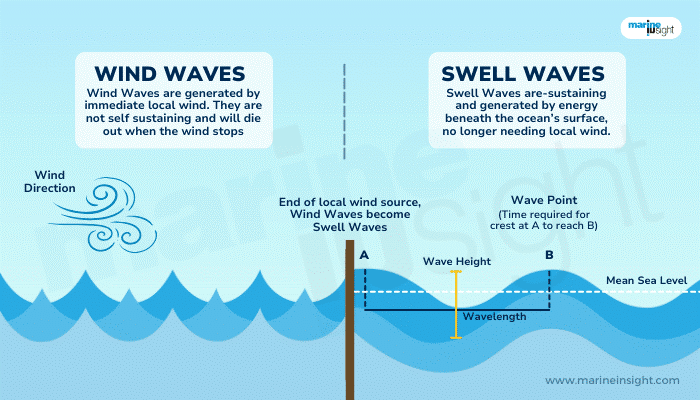Table of Contents
Swell Waves, Kallakadal
Context: The Indian National Centre for Oceanic Information Services (INCOIS) alerted the coastal states of India of the possibility of high-energy swell waves.
About Swell Waves
A swell consists of long-wavelength surface gravity waves in the ocean. These waves are distinct from local wind waves.

Formation
- Swells are generated not by local winds but by distant storms, such as hurricanes or extended periods of strong gale winds.
- During these storms, a significant transfer of energy from the air to the water occurs, resulting in the creation of high waves.
- These waves can travel thousands of kilometres from the storm centre before reaching the coast.
Features
- Swell waves exhibit a narrower range of frequencies and directions compared to locally generated wind waves due to the dispersion from their area of origin.
- Swells can move in directions independent of the wind direction, contrasting with a wind sea.
- Although typical swell wavelengths do not often exceed 150 metres, exceptionally severe storms can produce swells longer than 700 metres.
- Swells can arise without any local wind activity or precursors.
About Kalakkadal
- Kallakkadal is a type of coastal flooding unique to the pre-monsoon period (April-May) on India’s southwest coast, characterised by swell waves.
- The term, approved by UNESCO in 2012, combines the Malayalam words for ‘thief’ (Kallan) and ‘sea’ (Kadal), symbolising the sea’s sudden and unexpected encroachment.
Cause and Mechanism
- Triggered by distant ocean storms, Kallakkadal results from swell waves generated by strong winds or storms in the ocean, far from the local area.
- Specifically, the phenomenon is often due to strong winds in the southern Indian Ocean, with the latest event prompted by a low-pressure system from the South Atlantic Ocean, creating swell waves up to 11 metres high.
Warning Systems and Measures
- The Swell Surge Forecast System, introduced by the Indian National Centre for Ocean Information Services (INCOIS) in 2020, enables seven-day warnings, aiding in the preparation and mitigation of Kallakkadal.
- However, predicting Kallakkadal poses difficulties due to its sudden onset without prior signs or local wind movements.
- In these cases, the indigenous knowledge of fishermen and coastal dwellers becomes invaluable for recognizing and reacting to such phenomena.
Distinction from Tsunami
| Characteristic |
Tsunami |
Kallakkadal |
| Definition | Tsunamis are large waves triggered by underwater disturbances such as earthquakes. | Kallakkadal refers to coastal flooding in the pre-monsoon season due to swell waves on India’s southwest coast. |
| Wave Height | Heights can exceed 30 metres. | Waves usually range between 2 and 6 metres in height. |
| Wave Speed | Speeds can reach up to 800 km/h. | Waves move at speeds up to 50 km/h. |
| Cause | Caused by the sudden movement of water due to seismic events or landslides. | Generated by distant oceanic storms transferring energy to the sea surface. |
| Terminology | “Tsunami” comes from Japanese, meaning “harbour wave.” | “Kallakkadal” merges the Malayalam words for “thief” (Kallan) and “sea” (Kadal), recognized officially by UNESCO in 2012. |
Oxytocin
Context: Recent deliberations in the Delhi High Court have highlighted concerns about the rampant use of the hormone Oxytocin in dairy colonies across Delhi.
Background
Indian Government Regulations on Oxytocin
- In April 2018, the Central Government banned the private production and sale of Oxytocin, citing its misuse in dairy cattle to artificially increase milk production, which poses health risks both to animals and humans consuming the milk.
- Production rights were restricted to the public sector enterprise Karnataka Antibiotics and Pharmaceuticals Limited (KAPL) to control its distribution.
Court’s Directives
- The Delhi High Court, acting on a plea regarding the misuse of Oxytocin in dairies, recognized the administration of this hormone in cattle as a form of animal cruelty, a cognizable offence under Section 12 of the Prevention of Cruelty to Animals Act, 1960.
- The court has directed the Department of Drugs Control of the Government of the National Capital Territory of Delhi (GNCTD) to ensure stringent weekly inspections to curb this practice.
- These offences are to be investigated by local police stations where the dairy colonies are located.
About Oxytocin
Oxytocin is a hormone that is produced in the hypothalamus and released into the bloodstream by the pituitary gland.
| Hormones |
|
Function
- It manages key aspects of the female and male reproductive systems, including labour and delivery and lactation, as well as aspects of human behaviour.
- Its main function is to facilitate childbirth, which is one of the reasons it is called the “love drug” or “love hormone.”
Effects of Abnormal Oxytocin Levels
Low Oxytocin Levels
- Impact on Childbirth: Insufficient oxytocin can impede uterine contractions necessary for childbirth.
- Effect on Lactation: It may prevent the ejection of milk following birth.
- Underlying Causes: The most frequent cause of low oxytocin levels is panhypopituitarism, where all pituitary gland hormone levels are reduced.
- Association with Disorders: Low levels have been linked to conditions such as autism spectrum disorder and depression. Research is ongoing to explore the use of synthetic oxytocin in treating these disorders.
High Oxytocin Levels
- In Females: Excess oxytocin can lead to oxytocin toxicity, characterised by an overactive uterus and increased uterine muscle mass, potentially complicating pregnancy.
- In Males: High levels are associated with benign prostatic hyperplasia (BPH), a condition marked by an enlarged prostate gland which can obstruct the urethra and complicate urination. BPH commonly affects males over the age of 60.
ETA Aquariid Meteor Shower
Context: NASA said that the Eta Aquariid meteor shower is expected to peak on May 5 and 6.
Origin and Nature of Comets
- Comets, composed of ice, dust, and rock, originate from the early stages of the solar system about 4.6 billion years ago.
- These celestial bodies follow highly elliptical orbits around the Sun.
- As a comet nears the Sun, it heats up and releases gases and dust, forming a visible head and a long tail.
- Size variations: Mostly around 10 km wide, but can develop glowing heads larger than planets near the Sun.
- Currently, NASA recognizes 3,910 known comets, with many more believed to exist in distant orbits beyond Neptune.
Relationship Between Comets and Meteor Showers
- Meteor showers occur when Earth traverses through the dust clouds left behind by comets.
- The Eta Aquariid meteor shower is caused by debris from Halley’s Comet, which orbits the Sun every 76 years.
- As these particles enter Earth’s atmosphere, they burn up, creating bright streaks in the sky known as meteors.
| Source of Eta Aquariid Meteor Shower |
Facts about Eta Aquariid Meteor Shower
|
Examples, Case Studies and Data for Value Addition
- Status of Women in Indian Judiciary (GS 2): The Supreme Court of India reserved one-third of the seats in the executive committee of the Supreme Court Bar Association (SCBA) for women.
- Overall Representation: Approximately 300,000 women are part of the justice delivery system in India.
- Subordinate Judges: Women make up 35% of subordinate judges.
- High Courts: Women’s representation falls to 13% among high court judges.
- Supreme Court:
- The first woman to serve as a judge on the Supreme Court bench was Justice Fathima Beevi in 1989.
- Currently, there are only three women judges on the Supreme Court bench.
- There has never been a woman Chief Justice of India.
- High Courts Chief Justices:
- In over seven decades, only 16 women have served as chief justices in high courts.
- Out of 650 High Court judges today, only 76 are women.
- Justice Leila Seth was the first woman to become Chief Justice of a High Court (Delhi) in 1997.
- Role of Hydropower in Increasing Drought (GS 3): Recent droughts in Colombia and Ecuador have severely hampered energy supplied by hydropower.
- A drought fuelled by the El Nino weather phenomenon has reduced reservoir water levels in hydropower plants, which Ecuador and Colombia rely on for most of their electricity.


 GPS Spoofing and Its Impact in India: A ...
GPS Spoofing and Its Impact in India: A ...
 Amrit Gyaan Kosh Portal: A Comprehensive...
Amrit Gyaan Kosh Portal: A Comprehensive...
 UpLink Initiative: Launched by World Eco...
UpLink Initiative: Launched by World Eco...





















